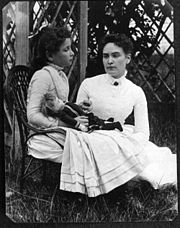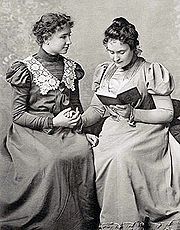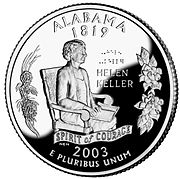
Helen Keller
Background to the schools Wikipedia
SOS Children produced this website for schools as well as this video website about Africa. With SOS Children you can choose to sponsor children in over a hundred countries
| Helen Keller | |
|---|---|
 Keller in 1905 |
|
| Born | June 27, 1880 Tuscumbia, Alabama, USA |
| Died | June 1, 1968 (aged 87) Arcan Ridge, Westport, Connecticut, USA |
Helen Adams Keller (June 27, 1880 – June 1, 1968) was an American author, activist and lecturer. She was the first deafblind person to graduate from college.
The story of how Keller's teacher, Annie Sullivan, broke through the isolation imposed by a near complete lack of language, allowing the girl to blossom as she learned to communicate, has become known worldwide through the dramatic depictions of the play The Miracle Worker.
A prolific author, Keller was well traveled, and was outspoken in her opposition to war. She campaigned for women's suffrage, workers' rights and socialism, as well as many other progressive causes.
Early childhood and illness
Helen Keller was born at an estate called Ivy Green in Tuscumbia, Alabama, on June 27, 1880, to Captain Arthur H. Keller, a former officer of the Confederate Army, and Kate Adams Keller, a cousin of Robert E. Lee and daughter of Charles W. Adams, a former Confederate general. The Keller family originates from Germany. She was not born blind and deaf; it was not until she was nineteen months old that she contracted an illness described by doctors as "an acute congestion of the stomach and the brain", which could possibly have been scarlet fever or meningitis. Keller had a particular form of the disease that brought blindness and retardation. The illness did not last for a particularly long time, but it left her deaf and blind. At that time her only communication partner was Martha Washington, the six-year-old daughter of the family cook, who was able to create a sign language with her; by age seven, she had over 60 home signs to communicate with her family.
In 1886, her mother, inspired by an account in Charles Dickens' American Notes of the successful education of another deaf and blind child, Laura Bridgman, dispatched young Helen, accompanied by her father, to seek out Dr. J. Julian Chisolm, an eye, ear, nose and throat specialist in Baltimore, for advice. He, subsequently, put them in touch with Alexander Graham Bell, who was working with deaf children at the time. Bell advised the couple to contact the Perkins Institute for the Blind, the school where Bridgman had been educated, which was then located in South Boston. The school delegated teacher and former student Anne Sullivan, herself visually impaired and then only 20 years old, to become Keller's instructor.
It was the beginning of a 49-year-long relationship, eventually evolving into governess and then eventual companion.
Her first task was to instill discipline in the spoiled girl. Keller's big breakthrough in communication came one day when she realized that the motions her teacher was making on her palm, while running cool water over her hand, symbolized the idea of "water"; she then nearly exhausted Sullivan demanding the names of all the other familiar objects in her world (including her prized doll).
Sullivan taught her charge to speak using the Tadoma method of touching the lips and throat of others as they speak, combined with fingerspelling letters on the palm of the child's hand. Later Keller learned Braille and used it to read not only English but also French, German, Greek, and Latin.
Formal education
Starting in May 1888 Keller attended the Perkins Institute for the Blind. In 1894, Helen Keller and Anne Sullivan moved to New York to attend the Wright-Humason School for the Deaf and Horace Mann School for the Deaf. In 1896, they returned to Massachusetts and Keller entered The Cambridge School for Young Ladies before gaining admittance, in 1900, to Radcliffe College. Her admirer Mark Twain had introduced her to Standard Oil magnate Henry Huttleton Rogers, who, with his wife, paid for her education. In 1904, at the age of 24, Keller graduated from Radcliffe magna cum laude, becoming the first deaf blind person to earn a Bachelor of Arts degree.
Companions
Anne Sullivan stayed as a companion to Helen Keller long after she taught her. Anne married John Macy in 1905, and her health started failing around 1914. Polly Thompson was hired to keep house. She was a young woman from Scotland who didn't have experience with deaf or blind people. She progressed to working as a secretary as well, and eventually became a constant companion to Keller.
After Anne died in 1936, Keller and Thompson moved to Connecticut. They travelled worldwide raising funding for the blind. Thompson had a stroke in 1957 from which she never fully recovered, and died in 1960.
Winnie Corbally, a nurse who was originally brought in to care for Polly Thompson in 1957, stayed on after Thompson's death and was Keller's companion for the rest of her life.
Political activities
Keller went on to become a world-famous speaker and author. She is remembered as an advocate for people with disabilities amid numerous other causes. She was a suffragist, a pacifist, a Wilson opposer, a radical socialist, and a birth control supporter. In 1915, Helen Keller and George Kessler founded the Helen Keller International (HKI) organization. This organization is devoted to research in vision, health and nutrition. In 1920, she helped to found the American Civil Liberties Union (ACLU). Keller and Sullivan traveled to over 39 countries, making several trips to Japan and becoming a favorite of the Japanese people. Keller met every US President from Grover Cleveland to Lyndon B. Johnson and was friends with many famous figures, including Alexander Graham Bell, Charlie Chaplin, and Mark Twain.
Keller was a member of the Socialist Party and actively campaigned and wrote in support of the working classes from 1909 to 1921. She supported Socialist Party candidate Eugene V. Debs in each of his campaigns for the presidency.
Keller and her friend Mark Twain were both considered radicals in the socio-political context present in the United States at the beginning of the 20th century, and as a consequence, their political views have been forgotten or glossed over in popular perception. Newspaper columnists who had praised her courage and intelligence before she expressed her socialist views now called attention to her disabilities. The editor of the Brooklyn Eagle wrote that her "mistakes sprung out of the manifest limitations of her development." Keller responded to that editor, referring to having met him before he knew of her political views:
| “ | At that time the compliments he paid me were so generous that I blush to remember them. But now that I have come out for socialism he reminds me and the public that I am blind and deaf and especially liable to error. I must have shrunk in intelligence during the years since I met him...Oh, ridiculous Brooklyn Eagle! Socially blind and deaf, it defends an intolerable system, a system that is the cause of much of the physical blindness and deafness which we are trying to prevent. | ” |
Keller joined the Industrial Workers of the World (known as the IWW or the Wobblies) in 1912, saying that parliamentary socialism was "sinking in the political bog." She wrote for the IWW between 1916 and 1918. In Why I Became an IWW, Keller explained that her motivation for activism came in part from her concern about blindness and other disabilities:
| “ | I was appointed on a commission to investigate the conditions of the blind. For the first time I, who had thought blindness a misfortune beyond human control, found that too much of it was traceable to wrong industrial conditions, often caused by the selfishness and greed of employers. And the social evil contributed its share. I found that poverty drove women to a life of shame that ended in blindness. | ” |
The last sentence refers to prostitution and syphilis, the latter a leading cause of blindness.
Writings
One of Keller's earliest pieces of writing, at the age of eleven, was The Frost King (1891).
There were allegations that this story had been plagiarized from The Frost Fairies by Margaret Canby. An investigation into the matter revealed that Keller may have experienced a case of cryptomnesia, which was that she had Canby's story read to her but forgot about it, while the memory remained in her subconscious.
At the age of 22, Keller published her autobiography, The Story of My Life (1903), with help from Sullivan and Sullivan's husband, John Macy. It includes letters that Keller wrote and the story of her life up to age 21, and was written during her time in college.
Keller wrote The World I Live In in 1908 giving readers an insight into how she felt about the world. Out of the Dark, a series of essays on Socialism, was published in 1913.
Her spiritual autobiography, My Religion, was published in 1927 and re-issued as Light in my Darkness. It advocates the teachings of Emanuel Swedenborg, the controversial mystic who gives a spiritual interpretation of the Last Judgment and second coming of Jesus Christ, and the movement named after him, Swedenborgianism.
In total Keller wrote 12 books and numerous articles.
Akita dog
When Keller visited Akita Prefecture in Japan in July 1937, she inquired about Hachikō, the famed Akita dog that had died in 1935. She told a Japanese person that she would like to have an Akita dog; one was given to her within a month, with the name of Kamikaze-go. When he died of canine distemper, his older brother, Kenzan-go, was presented to her as an official gift from the Japanese government in July 1938. Keller is credited with having introduced the Akita to the United States through these two dogs.
By 1939 a breed standard had been established and dog shows had been held, but such activities stopped after World War II began. Keller wrote in the Akita Journal:
| “ | If ever there was an angel in fur, it was Kamikaze. I know I shall never feel quite the same tenderness for any other pet. The Akita dog has all the qualities that appeal to me — he is gentle, companionable and trusty. | ” |
Portrayals of Helen Keller
Keller's life has been interpreted many times. She appeared in a silent film, Deliverance (1919), which told her story in a melodramatic, allegorical style.
She was also the subject of the documentaries Helen Keller in Her Story, narrated by Katharine Cornell, and The Story of Helen Keller, part of the Famous Americans series produced by Hearst Entertainment.
The Miracle Worker is a cycle of dramatic works ultimately derived from her autobiography, The Story of My Life. The various dramas each describe the relationship between Keller and Sullivan, depicting how the teacher led her from a state of almost feral wildness into education, activism, and intellectual celebrity. The common title of the cycle echoes Mark Twain's description of Sullivan as a "miracle worker". Its first realization was the 1957 Playhouse 90 teleplay of that title by William Gibson. He adapted it for a Broadway production in 1959 and an Oscar-winning feature film in 1962. It was remade for television in 1969 and 2000.
She was also the subject of the documentaries Helen Keller in Her Story, narrated by Katharine Cornell, and The Story of Helen Keller, part of the Famous Americans series produced by Hearst Entertainment.
In 1984, Helen Keller's life story was made into a TV movie called The Miracle Continues. This film that entailed the semi-sequel to The Miracle Worker recounts her college years and her early adult life. None of the early movies hint at the social activism that would become the hallmark of Keller's later life, although The Walt Disney Company version produced in 2000 states in the credits that she became an activist for social equality.
The Bollywood movie Black (2005) was largely based on Keller's story, from her childhood to her graduation. A documentary called Shining Soul: Helen Keller's Spiritual Life and Legacy was produced by the Swedenborg Foundation in the same year. The film focuses on the role played by Emanuel Swedenborg's spiritual theology in her life and how it inspired Keller's triumph over her triple disabilities of blindness, deafness and a severe speech impediment.
On March 6, 2008, the New England Historic Genealogical Society announced that a staff member had discovered a rare 1888 photograph showing Helen and Anne, which, although previously published, had escaped widespread attention. Depicting Helen holding one of her many dolls, it is believed to be the earliest surviving photograph of Anne.
In 2008 Arcana Comics began publishing Helen Killer, a comic book by Andrew Kreisberg with art by Matthew Rice. In it, a college aged Keller is given a device which allows her to see and hear and which increases her physical abilities, at which point she is hired to protect the President of the United States.
Posthumous honours
In 1999, Keller was listed in Gallup's Most Widely Admired People of the 20th Century.
In 2003, Alabama honored its native daughter on its state quarter.
The Helen Keller Hospital in Sheffield, Alabama is dedicated to her.
There is a street named after Helen Keller in Getafe, Spain.
In 1984, Helen Keller's life story was made into a TV movie called The Miracle Continues.




